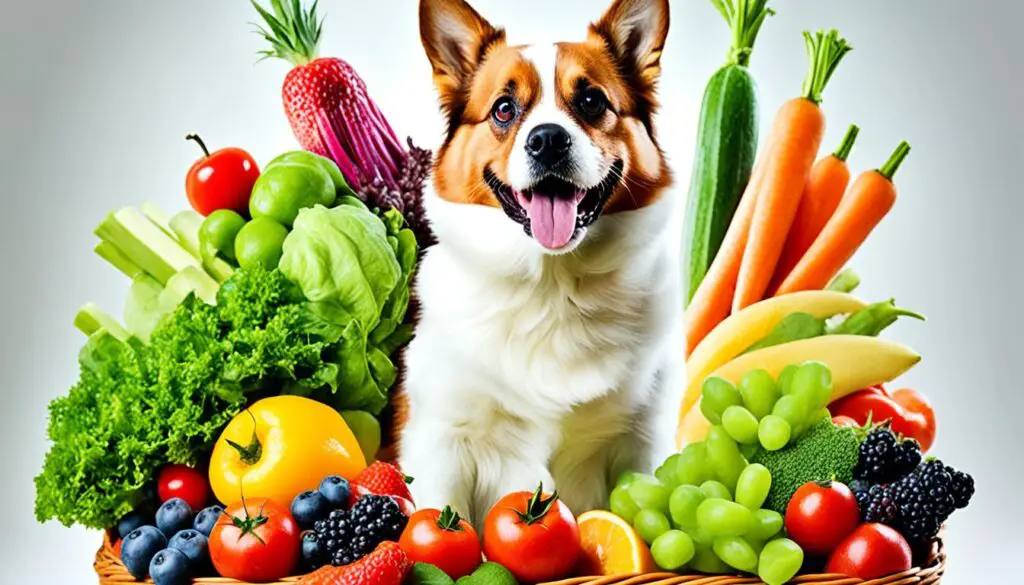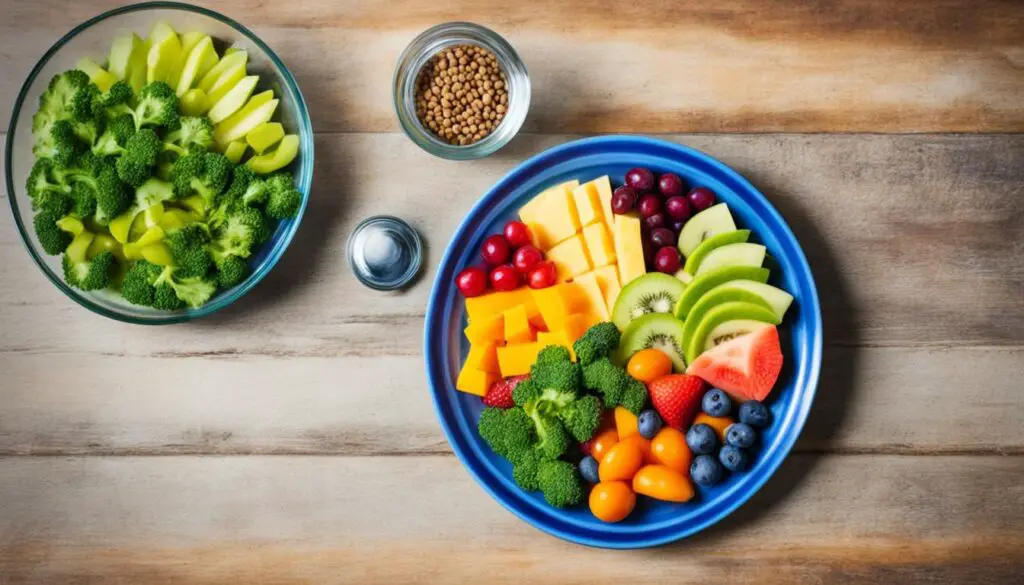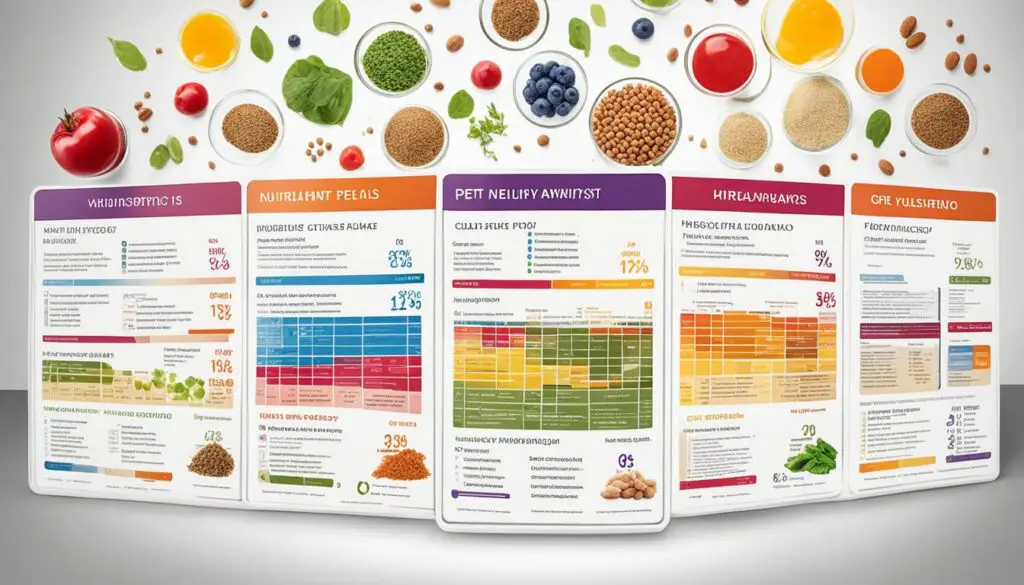Being a responsible pet owner means knowing about good nutrition for your pet. Pets, like us, need the right foods to be happy and healthy. With so many pet food options, it’s hard to know what’s best. That’s where I come in. I’ll share essential tips on nutrition to help your pet thrive.
Key Takeaways:
- Feeding your pet the right nutrients is crucial for their development, energy levels, and overall well-being.
- The six essential nutrients that every dog needs are water, fat, protein, carbs, vitamins, and minerals.
- Understanding the guaranteed analysis on the pet food’s nutrition label is essential for making informed choices.
- Quality ingredients and a nutritionally complete diet should be prioritized when choosing dog food.
- Consulting with a veterinarian is always recommended to determine the best diet for your pet’s specific needs.
Six Essential Nutrients Your Dog Needs
Dogs need six vital nutrients to stay healthy: water, fat, protein, carbs, vitamins, and minerals. Each one is crucial for your dog’s health and growth. As a pet owner, knowing what these nutrients do is key to your dog’s diet.
The Six Essential Nutrients for your Dog
1. Water: Water is super important for your dog. It keeps them hydrated, helps with body temperature, and digestion. Always keep fresh, clean water available for your dog.
2. Fat: Fat gives dogs energy and helps their skin and coat stay healthy. It helps dogs absorb vitamins too. You can find important fats in fish oil and flaxseed oil.
3. Protein: Protein helps build and repair your dog’s muscles. It’s also key for a healthy immune system. Great protein sources are meat, fish, and eggs.
4. Carbohydrates: Carbs give your dog the energy they need. They are found in grains, veggies, and fruits. These are essential for your dog’s energy.
5. Vitamins: Vitamins help with growth, cell function, and keeping the immune system strong. A diet with different fruits and veggies will give your dog the vitamins they need.
6. Minerals: Minerals keep your dog’s bones and teeth strong. They also help the body work well. Your dog’s diet should have calcium, phosphorus, potassium, and iron. Sometimes, supplements might be needed, but ask a vet first.
It’s very important to know and meet your dog’s nutritional needs. A balanced diet with these six nutrients will help your dog live a happy, healthy life.
| Nutrient | Function | Sources |
|---|---|---|
| Water | Hydration, nutrient absorption, waste elimination | Fresh water |
| Fat | Energy, organ protection, nervous system support | Fish oil, flaxseed oil |
| Protein | Muscle growth, repair, immune function | Meat, fish, eggs |
| Carbohydrates | Energy source | Grains, vegetables, fruits |
| Vitamins | Growth, cell function, immune system regulation | Fruits, vegetables |
| Minerals | Bone and teeth health, body function | Calcium, phosphorus, potassium, iron |
Guaranteed Analysis: The Nutrition Label of Pet Food
When picking out pet food, the guaranteed analysis on the label is key. It tells you what’s in the food. This helps you choose the best and most nutritious food for your pet.
The label shows the least protein and fat and the most fiber and moisture. These numbers give a quick look at the food’s key nutrients.
Let’s say a label says there’s at least 10% protein and 5.5% fat. Protein helps your dog grow strong muscles and a healthy immune system. Fat gives them energy and helps keep their body working right.
Knowing the guaranteed analysis helps make sure your pet gets what they need. But, pets have different needs. So, talking to a vet about your pet’s diet is a smart move.
A Closer Look at the Nutrition Label
Pet food labels offer more than just the guaranteed analysis. They also have ingredient lists, feeding tips, and more nutritional info.
“The nutrition label is like a roadmap to your pet’s health. It helps you navigate through the vast options available and make choices that can enhance their well-being.” – Dr. Emily Peterson, DVM
Read the ingredient list on the label carefully. Good pet food usually has real meat first. Stay away from foods with fillers like corn, wheat, or soy. These don’t offer much nutrition.
The label’s feeding guidelines suggest how much to feed your pet, based on their size and how active they are. But, you might need to adjust this to keep your pet at a healthy weight.
Some labels also mention extra vitamins and minerals. These can help your pet stay healthy.
By reading the label well, you can pick great food for your pet. This helps them stay healthy and happy.
Tips for Choosing the Right Dog Food
Choosing the right dog food is vital for your pet’s health. Look for real meat as the first ingredient. This shows the food has high-quality protein. Quality ingredients help your dog live a healthy and active life.
Stay away from fillers like corn, wheat, or soy. They offer less nutrition. Quality ingredients ensure your dog gets a balanced diet.
Check the ingredient order on the label. Ingredients listed first are more abundant. Pick foods that list real meat and top ingredients first. Also, think about your dog’s age, breed, and dietary needs. Picking the right food helps your dog get the nutrients it needs.
It’s smart to talk to a vet about your dog’s food. They offer advice based on your dog’s health. With their help and your commitment to quality food, your pet will be well-fed.
FAQ
What are the six essential nutrients that every dog needs?
Dogs need water, fat, protein, carbs, vitamins, and minerals to stay healthy.
Why is water important for dogs?
Water keeps dogs hydrated, helps with nutrient absorption, and gets rid of waste.
What is the role of fat in a dog’s diet?
Fat gives dogs energy, keeps organs safe, and helps their nervous system work well.
Why is protein important for dogs?
Protein supports growth, muscle building, and a strong immune system in dogs.
What is the role of carbohydrates in a dog’s diet?
Dogs get their energy from carbohydrates.
What is the importance of vitamins and minerals in a dog’s diet?
Vitamins and minerals are key for many body functions in dogs.
How can I understand the guaranteed analysis on the nutrition label of pet food?
The label shows minimum protein and fat and maximum fiber and moisture. This helps you know what’s in the food.
What should I look for in dog food to ensure it is nutritionally complete?
Choose dog food with real meat first. Avoid fillers like corn, wheat, or soy. Check the ingredient list order.
How can I choose the right dog food for my pet?
Think about your dog’s age, breed, and health needs. Talk to a vet to find the best food for your pet.



